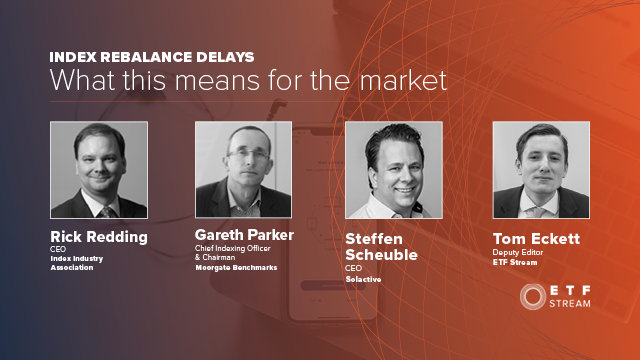The
of
ETF Stream’s
webinar series, ETF Ecosystem Unwrapped, examined the reasoning behind index providers’ decision to
delay the rebalancing of certain indices
following the recent periods of volatility, and the implications had on the rest of the industry.
Providing some context to the market environment over the past two months was Rick Redding, CEO of the Index Industry Association, who highlighted the peaks of volatility seen in March as multiple circuit breakers were activated at exchanges around the world and restrictions being enforced on short selling in numerous countries. This raised concerns surrounding the liquidity of the underlying markets.
The disruption to the rebalancing of indices impacted more than just ETFs that track the benchmarks. Redding added that “the index could be part of a far larger global index family which has component indexes such as sectors, industries, and factors,” and involves even more complications.
Steffen Scheuble, CEO of Solactive, discussed the role of index providers and how much human involvement should be expected. He said an index provider should not be allowed to make an “active” decision which leads to a rebalance delay.
Furthermore, he added that it is the index providers’ role to check there is enough liquidity available in the market for all the investors replicating an index.
Scheuble said the liquidity was sufficient enough for the equity market to implement the scheduled rebalances, however, “it was more expensive to trade as spreads widened”. This was not the case in the fixed income space where the lack of liquidity made it more appropriate to delay, he added.
It was widely understood by the industry why index provider made the intervention, but one issue with the rebalancing delays voiced by Gareth Parker, chief indexing officer and chairman of Moorgate Benchmarks, was the lack of follow-up afterwards.
After making such a monumental decision like postponing the rebalancing of indices, Parker said this was an opportunity for the index providers to explain why they made this decision, what they have learnt from this, and how they can improve their index methodologies and governance to avoid having to use discretion in that area in the future.
He added this was an ideal time for participants to offer some forward guidance which could be something produced at the same time as the use of discretion. For example, when announcing the rebalance delay, also include what volatility threshold must be met before carrying it out or what must the market conditions be like for it to be suitable.
Continuing on the importance of discretionary rules, Redding explained it is impossible to know when the next issue could occur and consequentially you cannot hardwire every response into these rules.
After significant events in the past 20 years like the tech bubble or the Global Financial Crisis, Redding argued firms have made changes to the rules, but if a ‘flash crash’ happened on the day of a rebalance then the discretionary rules in place would enable index providers to consult with market participants and do what is best for the market.
While some index providers made the decision to delay rebalancing some of their indices, some index provider continued business as usual and rebalanced all indices as expected. All speakers agreed this came down to the methodology of each firm and it is good to have variety.
Scheuble added investors should be able to make a choice on which index provider to track depending on its methodology and strategy otherwise if it was a one size fits all, there would only be a single index provider.
One regulatory change the European market is currently facing is the Benchmark Regulation (BMR). The panellists highlighted the pros and cons of the regulation and Parker emphasised the potential issues of ‘hastily’ including non-interest rate indices under this umbrella.
Solactive’s CEO Scheuble bemoans BMR rules around third-country index providers
“The rule is written in such a way that various rule exemptions are available for benchmark administrators using “regulated data” – but that “regulated” here only means data that is regulated in Europe,” Parker said.
“So we are in a strange scenario where an index provider using high quality, regulated data coming from non-EU countries, where there is not a European Union equivalent rule, has to nonetheless treat that data as unregulated and jump through extra hoops, even if that non-EU data is generally considered well-regulated and is widely accepted by the market.”
ETF Stream’s next webinar on 20 May will focus on the key developments on policy and regulation in the European ETF space. Register here.
Sign up to ETF Stream’s weekly email here





